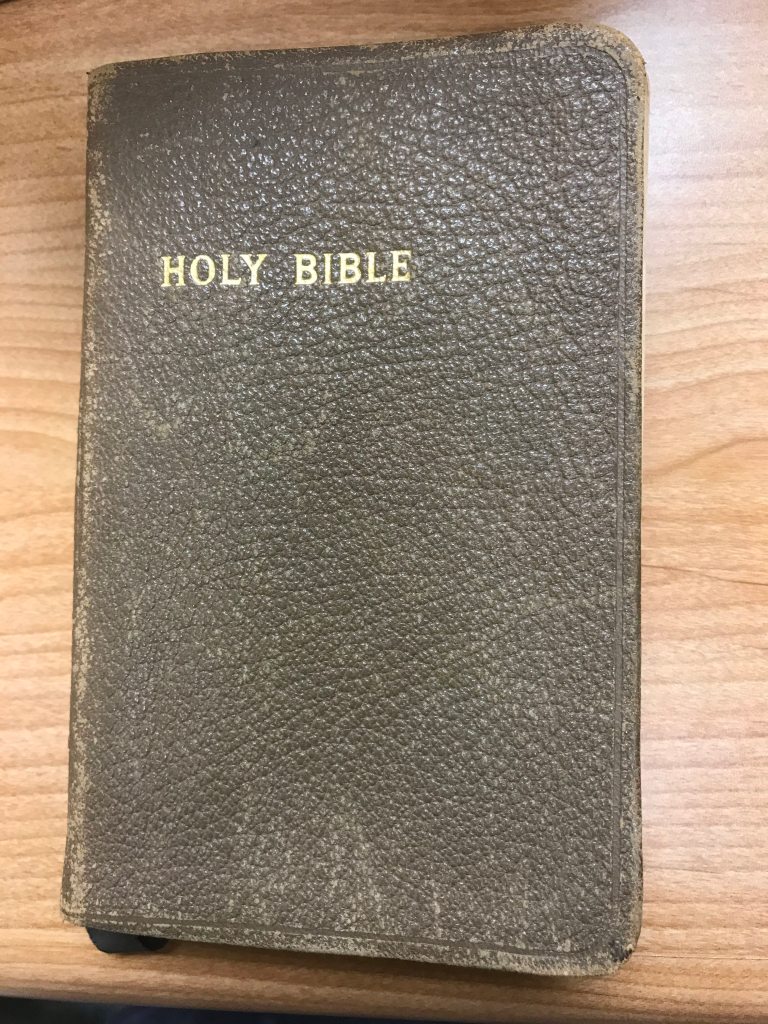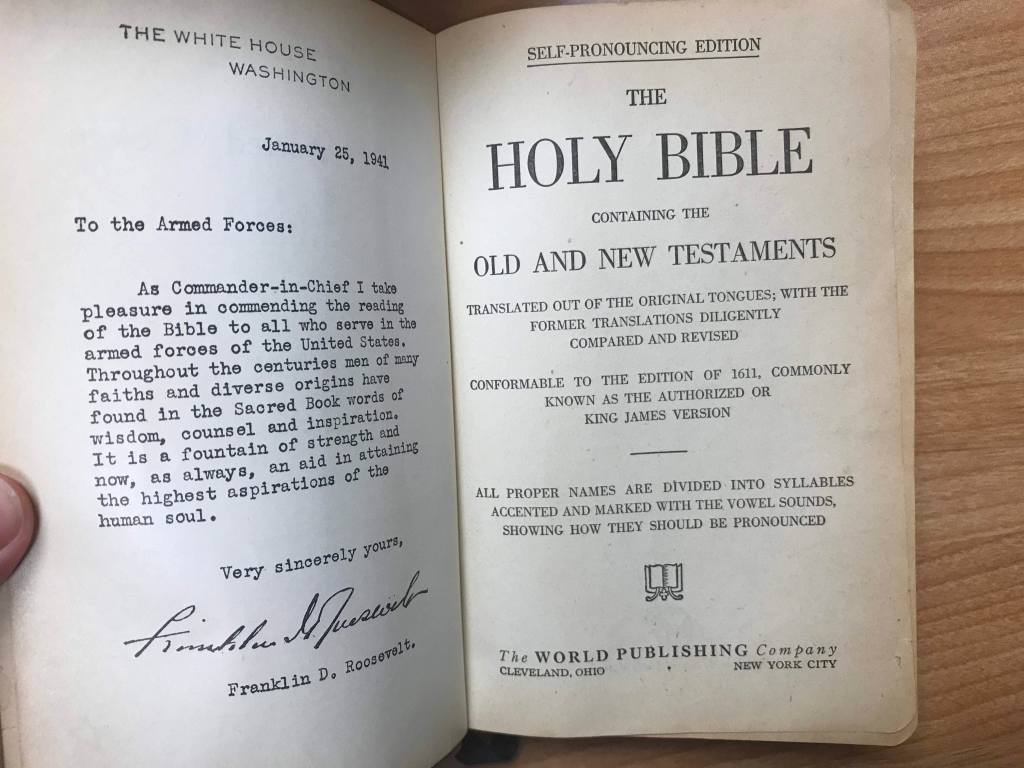Instead of writing about a specific library or museum, today, I want to write about how librarians can sometimes do detective work. I have had experience overseeing book donations and cataloging the books of an unprocessed library. For both tasks, I have always tried to scout out any books that seem potentially significant. I have done this by removing papers that are often inserted inside of books, or by inspecting older books, to see if there is anything noteworthy about them. Several times, this has led to some fun finds, which have sometimes required further detective work.
My favorite book donation mystery was a Bible that I ended up opening, even though it did not look special on the outside. Inside, I noticed a printed inscription by Franklin Roosevelt about the importance of the Bible, which was dated January 25, 1941. It was clearly a mass-produced military Bible, but it was confusing, since the United States did not enter World War II until December of 1941. This caused me to investigate further. I then learned that the United States Army had several large drafts prior to its entry into WWII, because it knew that U.S. involvement in the War was imminent. Of course, I had to contact the donor after I discovered this Bible. Sure enough, the donors did have family who served in WWII. They had not realized that the Bible was from WWII, so were excited to have it returned to them.


Another interesting donation mystery was solved by one of my colleagues. As he was going through some donations, he noticed a military bookplate inside the front cover of a book. After further investigation, he discovered that this particular bookplate meant that the book was once part of the many military libraries that the ALA (American Library Association) created for U.S. soldiers during World War I, both overseas and at military bases in the U.S. This particular book dated to 1912, which means that it was new during WWI (1914 to 1918).

My final library detective story did not require that I investigate the provenance of a book that I was cataloging, but I did anyway, because that is what makes monotonous work (which cataloging can sometimes be) fun.
The book that I was cataloging was volume 1 of The Jewish People, Past and Present, published by Jewish Encyclopedic Handbooks in 1946. Inside this book, I found a letter. Most of the time, the papers I find inside of books are receipts, bookmarks, or, sometimes, newspaper clippings. Because this was a letter, I knew that I should read it before throwing it away, just in case it mentioned something significant in regards to the book that I was cataloging. The letter’s envelope did not have a postage stamp, but did have a postmark that said, “Century of Progress World’s Fair Chicago 1933.” (Chicago has hosted two World’s Fairs, one in 1893 and the other in 1933.) Another postmark dated the envelope to “May 17, 1933.” If the envelope was dated to 1933, that means that the recipient must have thought that his letter was worth saving, since he still had it by 1946, which is when the book that I found the letter in was written.

Overall, the contents of the letter were not particularly interesting. In it, the writer explained how his business was doing well. He then asked the recipient to let him know when his graduation was, so that he could try to attend. I immediately came to the conclusion that this letter was from a father to his son away at college. I then read the names on the envelope. Both the sender and the recipient had the same last name, which confirmed my theory. Furthermore, the sender had a Chicago address, while the recipient had a Champaign, Illinois address. Since the University of Illinois is in Champaign, and since the sender mentioned a graduation, I guessed that the recipient was a college student there.
The sender used his own personal letterhead, which said that he was an architect. This piqued my interest, so I decided to expand my investigation to the internet. Sure enough, the one search result for his name showed me that a house he built is currently for sale in Illinois.
I then proceeded to Google the recipient’s name. The result was a University of Illinois graduation list from 1933, which showed that the recipient received a Bachelor of Science degree in Architecture that year. I then concluded that the recipient decided to become an architect because his father was one.
Searching the recipient’s name also brought me a link to the history of a Chicago-area synagogue. Since I found the letter in a book about Jewish history, this did not surprise me. I learned that one of the art pieces in the synagogue was dedicated in memory of the recipient, after he deceased, because he was a member of that synagogue.
Finally, my search led me to the 1930 United States census, which is freely accessible to the public, since all U.S. censuses become public after 70 years (next year, the 1950 census will be made public). This final search showed me that the sender and recipient of the letter were actually brothers, not father and son!
Isn’t it amazing how much you can learn about strangers just from one letter?

*November 29, 2019 Update: I was able to track down the grandson of the recipient of the 1933 letter and return it to him!
Sources and Further Reading
“1917.” American Library Association. http://www.ala.org/aboutala/1917 (accessed November 16, 2019).
“Meeting of the Board of Trustees of the University of Illinois, June 16, 1933, with Emergency Meeting of June 27, 1933.” University of Illinois Archives. https://archives.library.illinois.edu/erec/University%20Archives/0101802/02_volume_sections/1932-1934/14_meeting_1933-06-16.pdf (accessed November 16, 2019).
“United States Census, 1930.” www.familysearch.org (accessed November 16, 2019).
Very interesting! I really enjoy reading your posts.
LikeLike
Thank you! 🙂
LikeLike